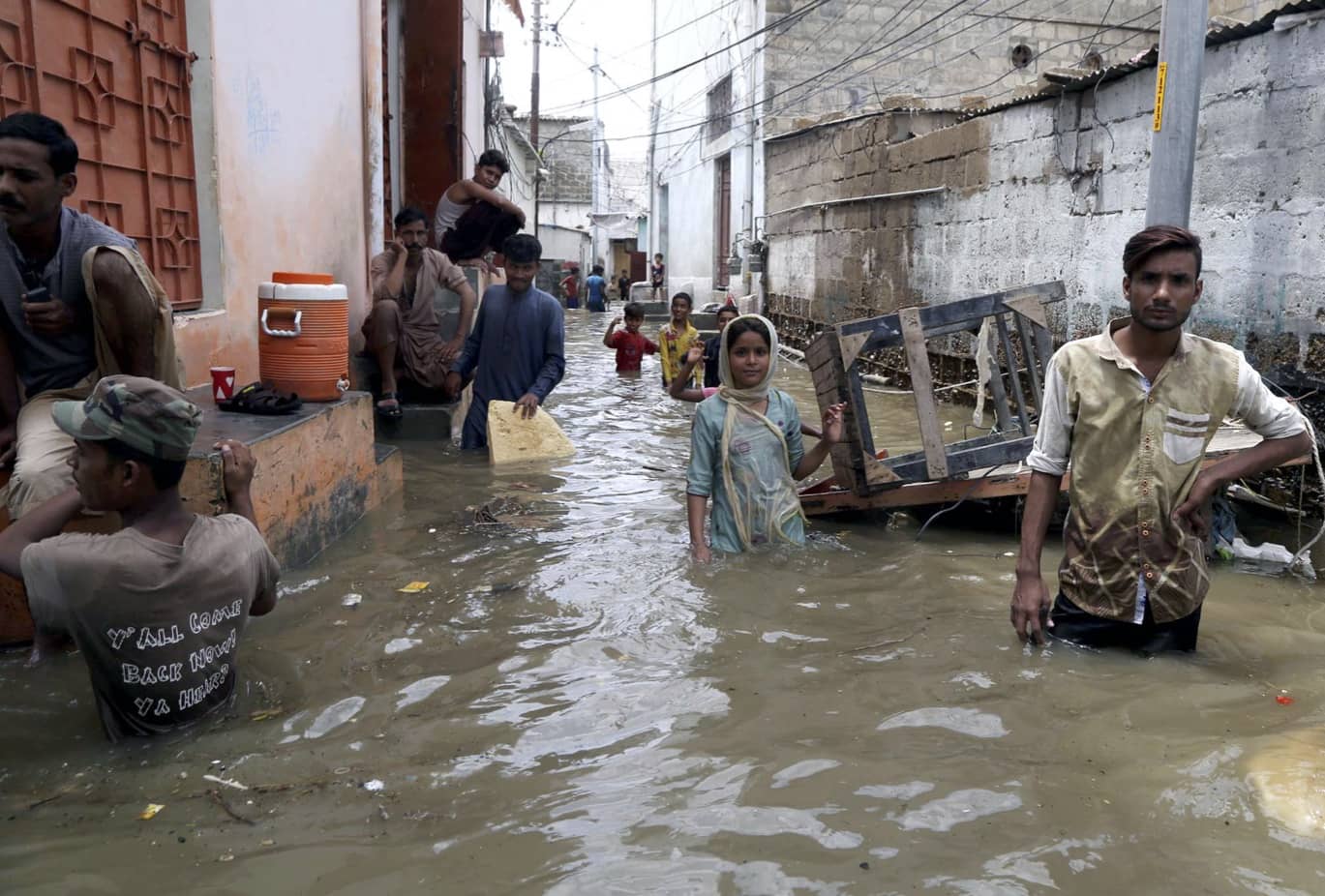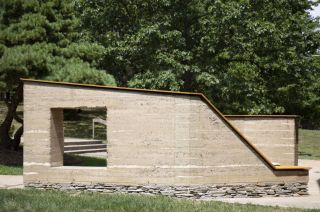
www.buildingsandcities.org/insights/commentaries/resilient-communities-pakistan.html
Creating Resilient and Sustainable Communities in Pakistan after Climate Devastation

In the face of imminent climate change, how can we rebuild in a more sustainable and resilient way?
In Pakistan, the climate crisis has already led to new heights of destruction, with more than 33 million people affected by intense flooding since July 2022 and approximately two million houses damaged. This poses an opportunity to reconsider conventional building practices. Rihab Khalid (University of Cambridge) highlights three critical areas for future resilient and sustainable building design in Pakistan.
Looking back to build forward
For climate resilience, buildings need to be designed for a given climate, rather than in spite of it. In Pakistan, the last 50 years have embraced modern construction practices. A proliferation of concrete, glass, steel and brick masonry structures in Pakistan reveal a climatic and cultural disconnect (Khalid and Sunikka-Blank, 2018). In contrast, vernacular buildings often show greater evidence of climate resilience than modernist practices and can provide useful learning for disaster-proofing buildings (Cruz-Ramírez, 2022). Contemporary climate-responsive design requires moving beyond a dichotomy of modernity and tradition towards integrated resilience.
In case of flood-prone areas in Pakistan, indigenous and traditional knowledge sources can prove beneficial as they are often based on long-term observations and experiences of local environments (ISDR, 2008). Examples include raised or buoyant structures made from locally sourced materials e.g. bamboo, earth and mud bricks (ARUP and IOM, 2017). The use of sustainable local materials like lime provide weather resistance while also prolonging the life of structures (Lari, 2015). The use of compact forms, appropriate orientation and axial placement of door and window openings to the flow of water can minimise flood damage (Dilhani and Jayaweera, 2016). Drawing on traditional passive design strategies like heavyweight construction, small window openings at elevated heights, and raised, pitched roofs can improve flood resilience. In terms of planning, strategies can include reducing flood water run-off through water catchments, flood walls and improved land infiltration- evident in indigenous land-use practices (ISDR, 2008).
Coupling traditional knowledge with technological innovation can provide promising strategies for adaptation and capacity building. For example, climate simulations and remote sensing for flood risk mapping can be used for disaster-proofing future buildings and identifying hazard-prone sites for proper planning and relocation (Rizwan et al., 2022). The use of innovative materials and prefabrication techniques can increase building resilience and speed up the recovery process. Similarly, a shift towards decentralised and distributed energy systems using renewable technologies can help meet basic electricity needs and ensure access to communication technologies for early warnings.
A socio-technical approach to building resilience
Socio-technical approaches to resilience are critical for a community's capability to flourish in a complex, unpredictable and rapidly changing system. This enables a community to 'bounce forward' after an extreme event (Manyena et al., 2011, p. 417) instead of simply bouncing back. Attention must be given to social cohesion, capacity building, channels of information and communication, and the empowerment of individuals and communities (Rajkovich and Okour, 2019), e.g. co-production and participatory approaches in design and planning.
A participatory approach builds on the adaptive capacity of a wide range of stakeholders (Bahadur and Tanner, 2014), including the most vulnerable. Examples of community-led and participatory building and planning initiatives already exist in Pakistan and have seen successful operation for years. One of the largest and most successful informal-settlement upgrading programs was initiated by the Orangi Pilot Project Research and Training Institute in the 1980s (Hasan, 2006). Since then, through community-government partnerships, the project has successfully carried out informal settlement upgrading and sewerage system development at approximately 250 locations in Pakistan. Similarly, co-production and community empowerment has been at the heart of architect Yasmeen Lari's Heritage Foundation, which has been working with displaced communities since the 2005 earthquakes. The Foundation has supported the building of thousands of low-cost, zero-waste, zero-carbon shelters, and other basic amenities, including developing means for livelihood. By building community self-reliance through training, mentoring and skills development, it has helped lift communities out of poverty along with building climate-responsive infrastructure (Lari, 2015).
Underlying socio-economic and techno-material inequities result in some populations facing greater climate vulnerability. Therefore, emerging adaptation initiatives will need to focus on issues of equity and justice (Kaswan, 2013), including gender justice (Buckingham and Kulcur, 2009). Climate adaptation and infrastructure rebuilding strategies should particularly address challenges for women and other marginalised and disadvantaged populations in terms of displacement, resettlement, loss of livelihoods, job creation, and land titling, etc (Orlando et al., 2018).
From prescriptive to performance-based regulations
Current building and planning codes need rethinking in light of the changing climate and future predictions of global warming (UNEP, 2021). Climate-responsive design requires multi-scalar and context-specific adaptation that integrates bottom-up community participation with top-down institutional governance and policymaking. Climate-responsive policies should allow for innovation and adaptation, while ensuring that building and planning regulations meet environmental standards for sustainability and resilience. This requires a shift away from prescriptive byelaws towards performance-based building regulations.
Prescriptive regulations, as seen in conventional building and planning codes, pose two critical challenges: 1) they inhibit development and change through innovation (Foliente, 2000); and 2) they invalidate and marginalise vernacular techniques and forms of construction that are often based on sensibilities of simplicity, functionality and passive means of comfort (Mumtaz, 1999).
Performance-based building regulations focus on outlining the desired outcomes (performance) without 'prescribing' the specific means to achieve them. This allows for greater adaptability and flexibility in design, construction and use (Becker, 2008), particularly for mainstreaming climate resilience. For example, multiple housing solutions can be proposed with comparable safety performance standards, but different resistance to water penetration, expected damage to building structures and maintenance cycles, depending on the specific context and occupant means (Watermeyer et al., 2003). Further, performance-based building and planning could accommodate diverse and indigenous forms of construction and infrastructure development which are proven to perform better in terms of sustainability and flood resilience. Thus, local low-cost informal housing could become 'formalised' and regulated by (appropriate) building codes. This would allow at-risk, vulnerable, and low-income communities to benefit from appropriate infrastructure and services relevant to resilience (Satterthwaite et al., 2020). This also provides greater potential for participatory planning, whereby local authorities can engage communities in envisioning their future habitats, integrating insights from multiple stakeholders.
For the scope and scale of adaptation required, climate and disaster risk reduction need to be fully encoded into all levels of decision-making. This requires new forms of climate-informed governance that integrate modern technologies with vernacular practices built on adaptive strategies and inclusive participatory design approaches that account for socio-technical resilience. This can only be achieved through strong coordination between multiple stakeholders. Policy bodies, local authorities, practitioners (engineers, architects, builders, planners, specialist contractors and emergency/risk managers etc), and professional institutes that operate at the top should work in collaboration with NGOs, social enterprises and local communities directly connected to the grassroots. This will ensure that housing is designed to meet community needs while being supported by appropriate standards, policies, and institutional capacity building for a climate-responsive future built environment in Pakistan.
References
ARUP & IOM. (2017). Pakistan Shelter Guide: Design for improved flood resilience in Sindh. ARUP, London/International Organization for Migration (IOM), Islamabad, Pakistan.
Bahadur, A. & Tanner, T. (2014). Transformational resilience thinking: putting people, power and politics at the heart of urban climate resilience. Environment and Urbanization, 26, 200-214.
Becker, R. (2008). Fundamentals of performance-based building design. Building Simulation, 1, 356-371.
Buckingham, S. & Kulcur, R. (2009). Gendered geographies of environmental injustice. Antipode, 41, 659-683.
Cruz-Ramírez, L.C. (2022). Identification of adaptive strategies in vernacular architecture facing flood risk. Sustainable Development and Planning XII. Southampton, UK: WIT Press.
Dilhani, K.A.C. & Jayaweera, N. (2016). A study of flood risk mitigation strategies in vernacular dwellings of Rathnapura, Sri Lanka. Built-Environment: Sri Lanka, 12(1).
Foliente, G.C. (2000). Developments in performance-based building codes and standards. Forest Products Journal, 50, 12-21.
Hasan, A. (2006). Orangi Pilot Project: the expansion of work beyond Orangi and the mapping of informal settlements and infrastructure. Environment and Urbanization, 18, 451-480.
IOM. (2022). Pakistan - Damage to houses due to foods and existing population density (as of 17 September 2022). IOM Displacement Tracking Matrix.
ISDR. (2008). Indigenous Knowledge for Disaster Risk Reduction: Good Practices and Lessons Learned from experiences in the Asia-Pacific Region. Bangkok: UN ISDR Asia Pacific.
Kaswan, A. (2013). Seven Principles for Equitable Adaptation. Sustainable Development Law and Policy, 13(1).
Khalid, R. & Sunikka-Blank, M. (2018). Evolving houses, demanding practices: A case of rising electricity consumption of the middle class in Pakistan. Buildings and Environment, 143, 293-305.
Lari, Y. (2015). Towards a Sustainable Future Build Back Safer with Vernacular Methodologies. Karachi: Heritage Foundation of Pakistan.
Manyena, B., O'Brien, G., O'Keefe, P. & Rose, J. (2011). Disaster resilience: a bounce back or bounce forward ability? Local Environment: The International Journal of Justice & Sustainability, 16, 417-424.
Mumtaz, K.K. (1999). Modernity and Tradition: Contemporary Architecture in Pakistan. Oxford University Press.
Orlando, M.B., Vanessa Lopes, J., Pranav, V., Nicolina, A., leva, Z. & Adams, N. (2018). Getting to Gender Equality in Energy Infrastructure: Lessons from Electricity Generation, Transmission, and Distribution Projects. Energy Sector Management Assistance Program (ESMAP) Technical Report 012/18. Washington, DC: World Bank.
Rajkovich, N.B. & Okour, Y. (2019). Climate change resilience strategies for the building sector: examining existing domains of resilience utilized by design professionals. Sustainability, 11(10), 2888.
Rizwan, M., Li, X., Chen, Y., Anjum, L., Hamid, S., Yamin, M., Chauhdary, J.N., Shahid, M.A. & Mehmood, Q. (2022). Simulating future flood risks under climate change in the source region of the Indus River. Journal of Flood Risk Management, e12857.
UNEP (2021). A Practical Guide to Climate-resilient Buildings & Communities. Nairobi: United Nations Environment Programme.
Watermeyer, R.B. & Milford, R.V. (2003). The use of performance-based building codes to attain sustainable housing objectives: the South African approach, in: Global Policy Summit on the Role of Performance-Based Building Regulations in Addressing Societal Expectations, International Policy, and Local Needs. Washington DC: IRCC, NRC, National Academy of Sciences.
Latest Peer-Reviewed Journal Content
Designing for pro-environmental behaviour change: the aspiration–reality gap
J Simpson & J Uttley
Lifetimes of demolished buildings in US and European cities
J Berglund-Brown, I Dobie, J Hewitt, C De Wolf & J Ochsendorf
Expanding the framework of urban living labs using grassroots methods
T Ahmed, I Delsante & L Migliavacca
Youth engagement in urban living labs: tools, methods and pedagogies
N Charalambous, C Panayi, C Mady, T Augustinčić & D Berc
Co-creating urban transformation: a stakeholder analysis for Germany’s heat transition
P Heger, C Bieber, M Hendawy & A Shooshtari
Placemaking living lab: creating resilient social and spatial infrastructures
M Dodd, N Madabhushi & R Lees
Church pipe organs: historical tuning records as indoor environmental evidence
B Bingley, A Knight & Y Xing
A framework for 1.5°C-aligned GHG budgets in architecture
G Betti, I Spaar, D Bachmann, A Jerosch-Herold, E Kühner, R Yang, K Avhad & S Sinning
Net zero retrofit of the building stock [editorial]
D Godoy-Shimizu & P Steadman
Co-learning in living labs: nurturing civic agency and resilience
A Belfield
The importance of multi-roles and code-switching in living labs
H Noller & A Tarik
Researchers’ shifting roles in living labs for knowledge co-production
C-C Dobre & G Faldi
Increasing civic resilience in urban living labs: city authorities’ roles
E Alatalo, M Laine & M Kyrönviita
Co-curation as civic practice in community engagement
Z Li, M Sunikka-Blank, R Purohit & F Samuel
Preserving buildings: emission reductions from circular economy strategies in Austria
N Alaux, V Kulmer, J Vogel & A Passer
Urban living labs: relationality between institutions and local circularity
P Palo, M Adelfio, J Lundin & E Brandão
Living labs: epistemic modelling, temporariness and land value
J Clossick, T Khonsari & U Steven
Co-creating interventions to prevent mosquito-borne disease transmission in hospitals
O Sloan Wood, E Lupenza, D M Agnello, J B Knudsen, M Msellem, K L Schiøler & F Saleh
Circularity at the neighbourhood scale: co-creative living lab lessons
J Honsa, A Versele, T Van de Kerckhove & C Piccardo
Positive energy districts and energy communities: how living labs create value
E Malakhatka, O Shafqat, A Sandoff & L Thuvander
Built environment governance and professionalism: the end of laissez-faire (again)
S Foxell
Co-creating justice in housing energy transitions through energy living labs
D Ricci, C Leiwakabessy, S van Wieringen, P de Koning & T Konstantinou
HVAC characterisation of existing Canadian buildings for decarbonisation retrofit identification
J Adebisi & J J McArthur
Simulation and the building performance gap [editorial]
M Donn
Developing criteria for effective building-sector commitments in nationally determined contributions
P Graham, K McFarlane & M Taheri
Join Our Community

The most important part of any journal is our people – readers, authors, reviewers, editorial board members and editors. You are cordially invited to join our community by joining our mailing list. We send out occasional emails about the journal – calls for papers, special issues, events and more.
We will not share your email with third parties. Read more



Latest Commentaries
COP30 Report
Matti Kuittinen (Aalto University) reflects on his experience of attending the 2025 UN Conference of the Parties in Belém, Brazil. The roadmaps and commitments failed to deliver the objectives of the 2025 Paris Agreement. However, 2 countries - Japan and Senegal - announced they are creating roadmaps to decarbonise their buildings. An international group of government ministers put housing on the agenda - specifying the need for reduced carbon and energy use along with affordability, quality and climate resilience.
Building-Related Research: New Context, New Challenges
Raymond J. Cole (University of British Columbia) reflects on the key challenges raised in the 34 commissioned essays for Buildings & Cities 5th anniversary. Not only are key research issues identified, but the consequences of changing contexts for conducting research and tailoring its influence on society are highlighted as key areas of action.